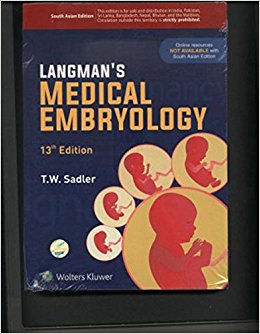Anwer Khan Modern Medical College
Library Management System

| Title: | Langman's medical embryology. |
| Author Name: | T W. Sadler |
| Author Sur Name: | SADLER, T. W. |
| Edition/Published: | 13th ed. _Philadelphia : Wolters Kluwer , 2015 |
| New to this edition: |
|
|
Physical Description: xiv, 407p, : <p>illustrations (some color)</p>.; 24cm. |
| Notes | Includes Bibliographical References and Indexes |
| Bibliography: | Page: 536-537 |
| Includes Index: | Page: 395-407 |
| ISBN No's: | 978-93-5129-624-9 |
| Bar Code's: | |
| Shelf Location's: | 83 |
| Classification | |
| Subject: | Embryology |
| Dewey Class No: | 612.6/4 |
| Letter Call No: | Sa1l |
| LC Classification: | QM601 .L35 2015 |
| Other's Book Information | |
| Book ID No: | 1895 |
| Total Books: | 1 |
| Date of collection's: | 29-Jan-2017 |
| Donation / Purchase: | Purchase |
| Language: | English |
| Status: | Available |
| Department: | Anatomy |
| Synopsis: |
|
| Review: |
|
| Description: |
|
| Key Features: |
|
| Summary: |
Offering exceptional full color diagrams and clinical images. Langman's Medical Embryology, 13th ed. helps medical, nursing and health professions students develop a basic understanding of embryology and its clinical relevance. Concise chapter summaries, captivating clinical correlates boxes, clinical problems, and a clear concise writing style make the subject matter accessible to students and relevant to instructors. |
| Abstract: |
Reaching far beyond the 9 months of gestation and the first year of life, embryonic development has ramifications for health throughout the human lifespan. Improved reproductive outcomes and healthier babies, while the specific goals of obstetricians, are areas of clinical relevance for all healthcare professionals. This book facilitates understanding of the molecular, cellular, and structural factors contributing to human development. With its trademark approach combining economy of text with exceptional artwork, this revised 12th edition clearly and effectively presents embryology in a clinical context for students of medicine and the health professions. Enhancements to the 12th edition include: An all-new introduction that covers the history and clinical relevance of embryology; Current research and detailed coverage of molecular regulation and signaling, the cardiovascular and digestive system, and the limbs; and each chapter includes overview figures that provide a visual introduction to the material. -- from Back Cover. |
| Preface: |
Every student will be affected by pregnancy, either their mother’s, because what happens in the womb does not necessarily stay in the womb, or by someone else’s. As health care pro- fessionals, you will often encounter women of childbearing age who may be pregnant, or you may have children of your own, or maybe it is a friend who is pregnant. In any case, pregnancy and childbirth are relevant to all of us, and un- fortunately, these processes often culminate in negative outcomes. For example, 50% of all em- bryos are spontaneously aborted. Furthermore, prematurity and birth defects are the leading causes of infant mortality and major contribu- tors to disabilities. Fortunately, new strategies can improve pregnancy outcomes, and health care professionals have a major role to play in implementing these initiatives. However, a basic knowledge of embryology is essential to the suc- cess of these strategies, and with this knowledge, every health care professional can play a role in providing healthier babies. To accomplish its goal of providing a basic understanding of embryology and its clinical relevance, Langmans Medical Embryology re- tains its unique approach of combining an econ- omy of text with excellent diagrams and clinical images. It stresses the clinical importance of the subject by providing numerous clinical examples that result from abnormal embryological events. The following pedagogic features and updates in the 13th edition help facilítate student learning. |
| Content: |
Part 1: General Embryology 1.Introduction to Molecular Regulation and Signaling 2.Gametogenesis: Conversion of Germ Cells into Male and Female Gametes 3. FirstWeek of Development: Ovulation to Implantation 4. SecondWeek of Development: Bilaminar Germ Disc 5. ThirdWeek of Development: Trilaminar Germ Disc 6. Thirdto Eight Weeks: The Embryonic Period 7. TheGut Tube and the Body Cavities 8. ThirdMonth to Birth: The Fetus and Placenta 9. BirthDefects and Prenatal Diagnosis Part 2:Systems-Based Embryology 10. TheAxial Skeleton 11.Muscular System 12. Limbs 13.Cardiovascular System 14.Respiratory System 15.Digestive System 16.Urogenital System 17. Headand Neck 18.Central Nervous System 19. Ear 20. Eye 21.Integumentary System Part 3:Appendix Answersto Problems FigureCredits Glossaryof Key Terms Index |
Related Books
- Langman's medical embryology.
- Atlas of human anatomy
- Atlas of human anatomy
- Clinical anatomy by regions
- Gray's anatomy: the anatomical basis of clinical practice
- Junqueira's basic histology: text and atlas
- Textbook of anatomy upper limb and thorax: vol. 1
- Textbook of anatomy head, neck and brain: vol. 3
- Textbook of human osteology: with atlas of muscle attachments
- Textbook of human osteology: with atlas of muscle attachments
